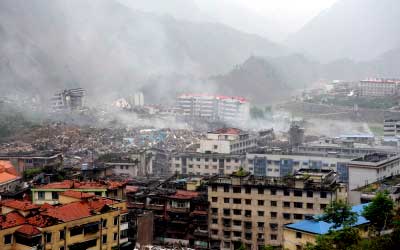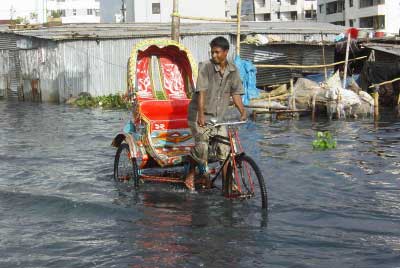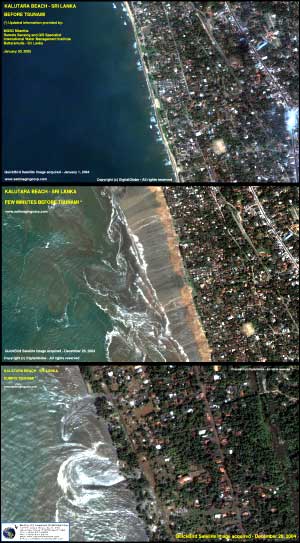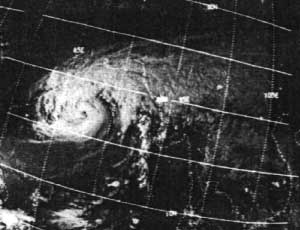The Neverending Battle with Nature
Natural disasters occur everywhere in the world, in all their various forms: earthquakes, volcanoes, tsunamis, hurricanes, floods... Their appearance naturally largely depends on climatic, meteorological, geological, geographical and human factors. Earthquakes and volcanoes, for example, are found most often at the edges of tectonic plates, hurricanes most frequently between the tropics. Because of its specific location and shape Asia is the continent where most natural disasters occur. It is also the most populous continent in the world. If we would rank all natural disasters of the past centuries by number of victims, Asia would even cover the entire top ten.

Beichuan, China after the devastation earthquake on May 12, 2008. Source: Houston China consulate
Earthquakes
Tectonic earthquakes are the result of an abrupt burst of energy released in the Earth’s crust, and usually occur in places where two tectonic plates move past or against each other. This will result in the Earth vibrating or shaking, caused by a sudden release of energy propagating in a wave motion from the centre to the environment. Usually, this shock has little effect on humans. It is the secondary events that make many victims: collapsing buildings, fires, volcanic eruptions, tsunamis...
Apart from the so-called Ring of Fire, tectonic earthquakes occur in several different geological contexts. The mid-oceanic ridges – where the oceanic plates diverge – are the location of many earthquakes. Another strong seismic zone is situated along the Mediterranean Sea, the Caspian Sea and the Himalaya, and ends at the Bay of Bengal.
The three earthquakes with the most victims all took place in China: in 1920 in Gansu (240,000 deaths) in 1976 in Tangshan (255,000) and in 1556 in Shaanxi (around 800,000).
Floods
A flood is any overflow or accumulation of an expanse of water that submerges land. The causes can be very diverse. Apart from the purely natural causes (the excession of a river’s capacity or the breaking of dikes due to heavy rain, storms, high tides, strong winds, sea surges caused by earthquakes, volcanic eruptions, etc), floods can also be caused by failure of human structures such as dams and levees, or in some cases even by deliberate actions of man. The floods with the most casualties are often the result of a combination of natural and human factors. A few examples:
In 1938 China was struck by the Yellow River Flood. Unlike one would expect, this flood was deliberately caused by the Nationalist Government during the early stage of the Second Sino-Japanese War in an attempt to halt the rapid advance of the Japanese forces. As a result, the course of the Yellow River was diverted southwards for nine years afterward, inundating 54,000 km². To achieve full surprise on the invading Japanese force, the Chinese Nationalist government decided not to inform the mass public before destroying the dike. It is estimated that about 870,000 people lost their lives and many millions were affected.
This still is not the worst flood in history. In 1887, another flood in the same Yellow River made numerous casualties; according to the Food and Agriculture Organisation of the UN 900,000 people lost their lives, but estimations by other organisations go as high as 2,000,000. For centuries the farmers living near the river had built dikes to contain the rising waters, caused by silt accumulation on the riverbed. In 1887 this rising riverbed, coupled with days of heavy rain, overcame the dikes causing a massive flood. The waters spread very quickly, covering an estimate 130,000 square kilometres, taking 300 villages. After the flood, two million people were left homeless.
But the worst flood in history – again in China – had even more devastating effects. The 1931 Central China floods are in fact a series of devastating floods in themselves, and are generally considered the deadliest natural disaster ever recorded. They were caused by exceptionally bad weather conditions: heavy snowstorms in the winter were followed by spring thaw/defrost with heavy rains that raised the river levels even higher. The rain increased into July and August of 1931. In July alone 7 cyclones hit the region –on average two occur per year. The human casualties are estimated from lows of 400,000 to highs of 3.7 million to 4 million.

Volcanoes
 Volcanoes are geological structures on the surface of the Earth through which magma is ejected. They are not randomly spread around the globe: like earthquakes the location of most volcanoes is closely related to tectonic plate boundaries. They are therefore most frequently found on diverging (oceanic ridges and continental rifts) and converging (subduction of lithospheric plates) plate boundaries. A very dense concentration of volcanoes is found around the Pacific Ocean, the so-called Ring of Fire.
Volcanoes are geological structures on the surface of the Earth through which magma is ejected. They are not randomly spread around the globe: like earthquakes the location of most volcanoes is closely related to tectonic plate boundaries. They are therefore most frequently found on diverging (oceanic ridges and continental rifts) and converging (subduction of lithospheric plates) plate boundaries. A very dense concentration of volcanoes is found around the Pacific Ocean, the so-called Ring of Fire.
The two volcanic eruptions with the most casualties occurred in this region. In 1815, Mount Tambora, a stratovolcano volcano in Indonesia, exploded so violently that one third of its full height was lost. The volcanic dust that was thrown in the upper layers of the atmosphere circled the entire earth several times, making temperatures in the Northern hemisphere decrease with 0.5 to 1°C and causing what would later be called “the Year Without a Summer” in Europe. The eruption was the most violent volcanic eruption ever recorded (even more so than the eruption of the Vesuvius), and also the most deadly one – 92,000 people lost their lives.
In 1883 exploded another stratovolcano in Indonesia, Mount Krakatoa, with such violence that the sound of the explosion could be heard in Australia. The eruption triggered a tsunami whose waves where felt all the way in Europe and which cost 36,000 lives.
The Krakatoa before and after the fatal explosion that killed 36,000 people.Source: Wikipedia
Tsunamis
A tsunami is a series of waves created when a body of water, such as an ocean, is rapidly displaced. The name is a Japanese composition of tsu (harbour) and nami (high wave). Apart from submarine earthquakes tsunamis can have numerous other causes: large icebergs breaking off of glaciers or ice shelves, submarine landslides, volcanic eruptions and even offshore meteorite impacts. They are most frequently formed in the Pacific, mainly because of the abundant tectonic activity near plate edges.
Since the population density in Asia is mainly concentrated in coastal areas, the impact of tsunamis is enormous. In Japan, the four largest tsunamis in the last 300 years cost almost 100,000 lives. Two tsunamis in Europe - one in Italy in 1908 and one in Lisbon in 1755 - each demanded another 100,000 victims. But the tsunami following the submarine earthquake in 2004 makes all others look feeble in comparison: in Asia almost 230,000 people were killed, the victims on the East African coast not included.
Tropical Cyclones
Tropical cyclones are storm systems with typically large low-pressure centres and numerous thunderstorms. They are born consistently above the ocean in the tropics, because the warm evaporating water (26 – 27°C at least 30 to 50 meters deep) adds energy to the low-pressure centre when it condensates high up in the atmosphere after having evaporated from the ocean’s surface. The first manifestation of such a weather system is called a tropical depression (as long as wind speeds do not exceed 63 km/h or 7 Beaufort). When the depression grows stronger (wind speeds between 63 km/h and 119 km/h) it is called a tropical storm. Storms with wind speeds that exceed 119 km/h or 12 Beaufort are tropical cyclones. They are referred to by various names. Hurricane is the most common name in the Northern Atlantic and the North-eastern Pacific; typhoons are tropical cyclones that come from the North-western Pacific; and tropical cyclones originating on the Indian Ocean are simply called cyclones.
– 27°C at least 30 to 50 meters deep) adds energy to the low-pressure centre when it condensates high up in the atmosphere after having evaporated from the ocean’s surface. The first manifestation of such a weather system is called a tropical depression (as long as wind speeds do not exceed 63 km/h or 7 Beaufort). When the depression grows stronger (wind speeds between 63 km/h and 119 km/h) it is called a tropical storm. Storms with wind speeds that exceed 119 km/h or 12 Beaufort are tropical cyclones. They are referred to by various names. Hurricane is the most common name in the Northern Atlantic and the North-eastern Pacific; typhoons are tropical cyclones that come from the North-western Pacific; and tropical cyclones originating on the Indian Ocean are simply called cyclones.
Since the storm is a low-pressure area, air will start moving to the centre of the storm. In this centripetal movement the air is subject to the Coriolis acceleration, caused by the rotation of the Earth. This makes the direction of the winds bend in counter-clockwise direction in the Northern hemisphere and in clockwise direction in the Southern hemisphere. Because of this Coriolis effect the storm starts to spin and grow.
mages before, during the lowering phase and during the rising phase of the tsunami of December 26, 2004 on the coast of Sri Lanka - Source
Since this effect is too weak near the equator and the sea is too cold too far away from it, tropical cyclones are mainly formed in two bands between the tropics (between 10 and 20 degrees North and South). Since tropical cyclones get their energy from the hot ocean surface waters, they quickly lose their strength over land.
 Even though North America and Australia are also visited by tropical cyclones, most victims are made in Asia: the ten tropical cyclones with most victims of the last 300 years, without exception took place in Asia. In 1839 a tropical cyclone claimed 300,000 lives in India, a typhoon in Vietnam in 1881 killed around the same number of people. In 1970 a cyclone collapsed on Bangladesh, which led to the death of 500,000 people.
Even though North America and Australia are also visited by tropical cyclones, most victims are made in Asia: the ten tropical cyclones with most victims of the last 300 years, without exception took place in Asia. In 1839 a tropical cyclone claimed 300,000 lives in India, a typhoon in Vietnam in 1881 killed around the same number of people. In 1970 a cyclone collapsed on Bangladesh, which led to the death of 500,000 people.
These are just a few of the natural disasters that have threatened mankind over the ages. Blizzards, avalanches, mud flows, droughts, fires, etc. also belong in that category. Although they are not caused directly by humans, the frequency or intensity of some natural disasters might increase due to human factors, particularly global warming.
NOAA image of the Bhola Cyclone that killed half a million
people in Bangladesh in 1970 - Source: Wikipedia
Sources
Consequences of Rotation for Weather (University of Tennessee)
Floods and Droughts (FAO)
How Volcanoes Work - Krakatau, Indonesia (San Diego State University)
Les cyclones - Voyage au coeur de la Climatologie
Les volcans Planète Terre, Université Laval Québec
National Geographic on Natural Disasters
Natural Disasters & Severe Weather (Centers for Disease Control and Prevention)
NOAA Pacific Tsunami Warning Center
USGS Earthquake Center
Wikipedia on Floods - Coriolis Effect - Earthquakes - Typhoons
Links
This page was written in 2009, as additional information to the poster series "10 years of Imaging the Earth"